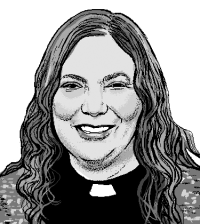Seeing myself in the story of the Feast of the Visitation
I've long identified with Mary's fire. Now I want to learn from Elizabeth.

I come again to the story of the Feast of the Visitation after 36 years of pastoral ministry. When my younger self chose it as my ordination text, I identified with Mary’s youthful revolutionary fire. I still do. But as I age, I’ve begun to see myself in Elizabeth, and I’m noticing some new components in the story as well.
According to Luke, as soon as the angel Gabriel departs, Mary hurries off to visit her cousin. We’re given a detail that only now has begun to intrigue me: the visit lasts three months. Why does Luke mention three months? If Luke was a beloved physician, as Paul claims, he would surely know that the first three months are a most vulnerable time of pregnancy. A large percentage of miscarriages happen in the first trimester, and many women choose not to share news of their pregnancy until the first three months have passed.
Dr. Luke would also know about morning sickness. While every body is different, morning sickness is most common during the first three months. For the majority of women, the body adjusts to the rush of hormonal changes by the end of the first trimester, and morning sickness goes away. It seems that Mary hastens to reach Elizabeth before morning sickness can have a chance to seriously hinder her travels. I wonder if she ends up staying three months because it takes that long before she feels well enough to make the return trip. For many women, and this was certainly my experience, morning sickness is 24/7.
In Spanish the term is malabarriga, or “evil belly.” Mary’s revolutionary Magnificat comes to us out of these three months of malabarriga, a time of churning upheaval in her body and in the social body she was part of. We can imagine her anxiety and uncertainty, the gossip swirling around her, leaving her vulnerable to the miscarriage of justice, the threat of community rejection and possible death.
All this is taking place at Elizabeth’s home in Judea, a Roman colony under the rule of Herod—a narcissistic tyrant known for massive building projects including housing, palaces, and an enormous wall. Herod is known to have been a paranoid ruler whose ego knew no boundaries or controls, who lashed out at those he determined to be against him—a disturbed personality who put the vulnerable in peril. It was, and is, enough to give anyone a bad case of malabarriga.
Just as Mary’s body needs to adjust to a flood of hormonal change, so it is with the church. It’s a time of changing racial demographics and challenges that shock the system of white supremacy, both outside and inside many churches. Generational changes impact church attendance and provoke questions around worship styles, leadership styles, and what meaningful mission looks like. Increasing numbers of people reject rigid binaries around gender and sexuality that were once accepted norms. All this and more can cause churning stomachs and unsettled hearts and minds. Many people get queasy while absorbing Mary’s words of some people being brought down from positions of privilege while others are lifted up so that a true, beloved community can be formed.
Feeling sick is generally a sign that something is wrong. We want to do everything possible to get rid of whatever is causing us to feel ill. We can probably all think of churches that have closed and that are about to close because they would rather die than live through uncomfortable changes. The time Mary shared with Elizabeth likely involves its share of discomfort, but it is also a liminal space—pregnant with hope, with the future, with Christ.
For Luke, three months is always such a generative time. In Acts, Luke tells us that Paul stays in Ephesus for three months and speaks boldly to the people there. Then he stays in Greece for three months of sanctuary, a safe place in the face of violent plots against him. Later, after the ship carrying him to Rome to stand trial is wrecked in a storm, Paul and his captors stay on the island of Malta for three months, another season of sanctuary and preparation for next steps.
And so, the very young Mary seeks out her older cousin Elizabeth, who is in her sixth month, for a safe space, comfort, wisdom, and support at a time when many are against her. We understand that Mary needs Elizabeth—but Elizabeth also needs Mary. Elizabeth is closer to the age of many in our pews. Elizabeth’s generation is aging, and their church is not birthing the new children they hoped for. According to the numbers, their church is barren. But this story sees things differently. Mary and Elizabeth carry the future together: “According to the promise God made to our ancestors, to Abraham [and Sarah] and to [their] descendants forever.” In God’s mercy, one generation needs the other.
The new life that has taken flesh in Elizabeth’s aging body is intimately connected to the embryonic hope in Mary’s body, and Elizabeth feels it in her own belly: “For as soon as I heard the sound of your greeting, the child in my womb leaped for joy. And blessed is she who believed that there would be a fulfillment of what was spoken to her by the Lord.”
I know this feeling. I know the joyful quickening in my soul when I see seminarians I’ve mentored graduating and getting ordained to live out their own magnificent visions. I know the flutter in my stomach as I hear their sermons and podcasts, read their stunning books, and witness the transformative communities they are forming. I know the leap of joy when our young congregational president greets the church, leads in the sanctuary, organizes in the street, and mentors fellow DACA recipients on possible futures.
And here is the takeaway for me and for others in my generation to note: both women are bearing new life, but the older Elizabeth privileges the younger Mary’s pregnancy. Elizabeth prioritizes Mary’s need for hospitality and sanctuary. Perhaps most importantly, Elizabeth shows a preferential option for Mary’s voice and vision over her own.
I want to learn how to pattern myself on Elizabeth. She utters a word of affirmation and blessing, and she steps aside so that the voice of Mary may sing out. Elizabeth models a way forward for older generations in the church: sometimes we must stand down, sit down and be quiet, so that the voices and visions of another generation can be heard.
Does that mean that I should stop speaking out? Stop preaching and writing? Do not these days call for a chorus of voices from every corner and generation? Does not the Spirit of Pentecost invite both old and young to share their dreams and visions? I think the answer is yes, but a cautionary yes that does not allow us elders to cling to roles and positions while young leaders must wait on the sidelines before they are taken seriously. So, when to support and when to step back? When to speak affirmation and blessing and when to be silent?
I don’t have all the answers, and I know that the fire of Mary continues to burn in my soul. But it’s also time to learn from the wisdom and grace of Elizabeth.





